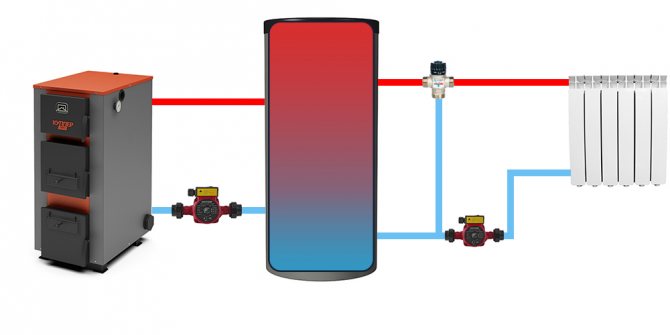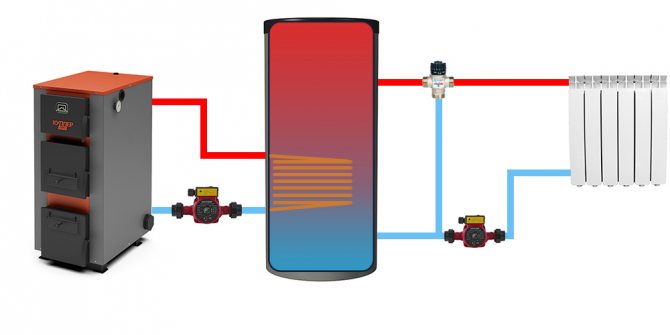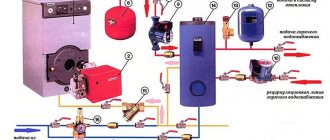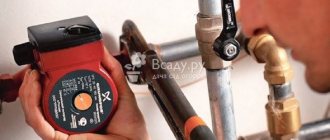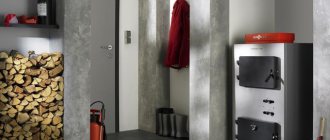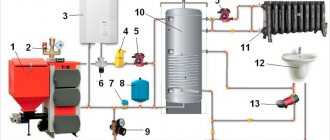Features of installing heat accumulators
All installation work is carried out according to a previously approved project in accordance with the recommendations of the heating equipment manufacturer.
In this case, the features of the installation work should be taken into account:
- The surface of the storage tank must be insulated from heat loss without fail.
- Thermometers should be installed on pipelines through which water circulates (outlet and inlet).
- Accumulator tanks with a volume of more than 500 liters in most cases do not pass through the doorway. In such cases, you should use collapsible structures or install several batteries of a smaller volume.
- At the lowest point of the tank, the installation of a drainage channel will not interfere. It comes in handy when you have to completely drain the water.
- It is advisable to install strainers on the pipelines through which water enters the container. They will prevent large inclusions from getting inside (scale from welding, minerals that have got into the system, etc.).
- If an air exhaust valve is not provided in the upper part of the container, then it should be installed at the upper point of the outlet pipe.
- A pressure gauge and a safety valve must be installed on the line next to the battery.
If you are the owner of a solid fuel boiler and have not yet purchased a heat storage device, think about it. You will not only extend the life of your heating equipment, but also significantly save on fuel.
Functionality of heat accumulators
The principle of operation of the equipment is that during the operation of the boiler, part of the heat is used to heat the coolant from the additional tank. The connected tank has good thermal insulation and perfectly retains the received heat. After the boiler is turned off, the water in the heating system cools down, and the control devices turn on the pump supplying hot water from the storage tank.
These cycles continue as long as the water temperature in the additional tank remains high enough. The total operating time of the system without turning on the boiler depends on the volume of the additional tank. In practice, it allows you to heat rooms from several hours to 2 days.
The heat accumulator performs the following functions:
- It accumulates heat coming from the system boiler and releases it over time to heat the rooms in the room.
- Prevents the possibility of boiler overheating by taking away excess heat from the exchanger.
- Allows you to easily combine different heating devices (electric, gas, solid fuel) into a common system.
- Helps to improve the performance of heating equipment, reducing fuel consumption and improving efficiency.
- In systems with solid fuel boilers, it allows you to exclude constant monitoring of the state of heating equipment. Heating the coolant in an additional tank, homeowners can forget about the need to constantly load fuel into the boiler.
- It is a source of hot water for domestic needs.
Heating system diagram
How profitable a heating system with a heat accumulator can be considered with this example.
Suppose that a 10 kW boiler is installed in the heating system. Every 3 hours it is necessary to load firewood. This does not fit into the plans of the homeowners in any way. In order to lengthen the intervals between loads, it is necessary to use a boiler with a higher capacity. But in this case, the boiling of the coolant is possible, since the system will not have time to take away all the generated heat.
Connecting a heat accumulator with a capacity of about 200 liters solves the problem easily.The equipment allows to accumulate 110 kW of energy provided that the boiler is fully and frequently loaded. Subsequently, the accumulated heat will maintain a comfortable room temperature for about 10 hours. Boiler loading with fuel is not needed all this time.
What is a heat accumulator buffer capacity and its purpose.
The purpose of the heat accumulator (TA) will be easier to describe using several example tasks.
The first task. The heating system is built on the basis of a solid fuel boiler. It is not possible to constantly monitor the temperature of the coolant at the supply and toss up firewood in time, as a result of which the supply temperature either exceeds the one we need, then it drops below the norm. How to maintain the required coolant temperature?
The second task. The house is heated with an electric boiler. Electricity supply is two-tariff. How to reduce energy costs by reducing energy consumption during the day and increasing at night?
The third task. There is a heating system in which heat is generated by heat generators operating on various types of fuel and energy - for example. gas, electricity, solar energy (solar collectors), earth energy (heat pump). How to ensure their efficient operation without loss of generated heat, when there is no need for it, while providing the house with heat during the period of peak energy consumption?
Without going too far into the theory of heat engineering, for all problems a solution suggests itself in the form of installing a buffer tank in the system, which would serve as a reservoir for the coolant and in which its temperature would be maintained at a given level. It is precisely such a buffer capacity that a heat accumulator is. To solve these problems, the heat accumulator is usually included "in the break" of the system with the formation of the boiler and heating circuits. A conventional diagram of the inclusion of a heat accumulator in the heating system is shown in the figure below.

Fig. Schematic diagram of switching on a buffer tank (heat accumulator)
The various ways of connecting the buffer tank to the heating system can be found in the article "Heat accumulator connection diagrams".
Currently, heat accumulators are most often used in heating systems with solid fuel boilers. In these systems, the use of a heat accumulator makes it possible to load fuel less often, to provide a comfortable supply of heat regardless of fluctuations in the temperature of the coolant at the outlet of the boiler. Often, buffer tanks are installed with electric boilers to save money due to a reduced night rate and in combined systems with the simultaneous use of solid fuel and electric boilers. A heat accumulator (TA) is useful in systems and with gas boilers, especially when the minimum heat output of the boiler exceeds the heat load of the facility. Due to the longer periods of "loading" of the TA (heating of the coolant), it is possible to avoid the "clock" of the boiler.
In addition to being used as a buffer tank, the TA performs the function of a low loss header. This property of the heat accumulator is especially in demand in systems with heat generators operating on different types of energy (including alternative). As a rule, these heat sources operate on special heat carriers that do not allow mixing with other types, require a unique temperature and hydraulic regime, which is often incompatible with the heating circuit modes (radiator, underfloor heating). For example, the temperature range of a heat pump is usually
5 ° C, and in the heat distribution loop the temperature range can be much larger (10-20 ° C). To separate the circuits, the heat accumulator can be equipped with additional built-in heat exchangers.
Wiring and connection diagrams
| Simplified pictorial diagram (click to enlarge) | Description |
| Standard wiring diagram for "empty" buffer tanks to a solid fuel boiler. It is used when there is a single heat carrier in the heating system (in both circuits: before and after the tank), the same permissible operating pressure. |
| The scheme is similar to the previous one, but assuming the installation of a thermostatic three-way valve. With such an arrangement, the temperature of the heating devices can be adjusted, which makes it possible to use the heat accumulated in the tank even more economically. |
| Connection diagram for heat accumulators with additional heat exchangers. As already mentioned more than once, it is used in the case when a different coolant or higher operating pressure is supposed to be used in a small circuit. |
| Diagram of the organization of hot water supply (if there is a corresponding heat exchanger in the tank). |
| The scheme assuming the use of 2 independent sources of thermal energy. In the example, this is an electric boiler. Sources are connected in order of decreasing thermal head (top-down). In the example, first comes the main source - a solid fuel boiler, below - an auxiliary electric boiler. |
As an additional source of heat, for example, instead of an electric boiler, a tubular electric heater (TEN) can be used. In most modern models, it is already provided for its installation by means of a flange or coupling fastening. By installing a heating element in the corresponding branch pipe, you can partially replace the electric boiler or once again do without kindling a solid fuel boiler.
It is important to understand that these are simplified, not complete wiring diagrams. To ensure control, accounting and safety of the system, a safety group is installed at the boiler supply. In addition, it is important to take care of the operation of the CO in the event of a power outage, because there is not enough energy to power the circulation pump from the thermocouple of non-volatile boilers. The lack of circulation of the coolant and the accumulation of heat in the heat exchanger of the boiler will most likely lead to a rupture of the circuit and an emergency emptying of the system, it is possible that the boiler burns out.
Therefore, for the sake of safety, it is necessary to take care of ensuring the operation of the system at least until the bookmark is completely burned out. For this, a generator is used, the power of which is selected depending on the characteristics of the boiler and the duration of combustion of 1 fuel insert.
How to calculate the volume of a heat accumulator
If desired, it is easy to find methods for calculating the volume of a heat accumulator on the Internet, but none of them suited me.
Some "experts" recommend multiplying the maximum power of the existing boiler in kilowatts by some factor, and this factor on different sites differs twice or more - from 25 to 50. In my opinion, this is complete nonsense. Simply because the result obtained has nothing to do with your particular home, or your wishes for how often you want to heat the boiler.
A normal technique takes into account all factors: the climate in your area, and the thermal insulation of the house, and your ideas about comfort. In an amicable way, this calculation will also need to be carried out many times for different temperature conditions, and select the maximum volume of the heat accumulator. And, by the way, the power of the boiler in the correct method is obtained as a result of calculations, and not according to the principle "what it was, it was delivered like this." But all this is quite complicated, and is more suitable for boiler rooms, and not for private households.
I did it much easier. I did the calculation of the heat accumulator for a solid fuel boiler as follows.
- It is necessary to estimate the amount of heat required by the house per day. This is the most difficult and responsible part of the job. Again, you can delve into the calculations (in textbooks for construction universities, you can find all the necessary techniques).But, if possible, it is easier and more reliable to carry out a direct measurement - simply by heating the house in cold weather and measuring the amount of fuel used. My house is relatively small - a little less than 100 sq. m, and quite warm. Therefore, it turned out that at an outside temperature of about 0 degrees, to maintain a comfortable temperature, 50 kW * h is required with a solid margin, for - 10 degrees - 100 kW * h, for - 20 degrees - 150 kW * h.
- Choosing a boiler is very simple. The most common boilers have a power of about 25 kW and from one maximum load give this power for about 3 hours. Therefore, one kindling gives about 75 kWh of heat. For zero temperature, therefore, even one full load will be too much for me. And for -20 degrees, it will be enough to heat 2 times a day. I was quite satisfied with this option.
- Now the actual volume of the heat accumulator. The heat capacity of water is 4.2 kJ per liter per degree. the maximum temperature in the heat accumulator is 95 degrees, the comfortable temperature of the water in the heating system is 55 degrees. That is, 40 degrees of difference. In other words, 1 liter of water in a heat accumulator can store 168 kJ of heat, or 46 Wh. And 1000 liters, respectively - 46 kWh. It follows that in order to keep the heat from one full load of the boiler, I need a heat accumulator for 1500 liters. This is all with a margin. In fact, it takes a little less, but after studying the prices for buffer tanks, I decided to ignore this.
This calculation means that in severe frosts I have to heat the boiler twice a day, and in very severe frosts three times. Moreover, this should be done evenly throughout the day: in the morning and evening or in the morning, at the beginning of the evening and before bedtime. And when there is no big frost, I fire the boiler only once - at any time of the day.
Of course, if you put an even larger heat accumulator, you can make your life even more comfortable. But here we already have to face the fact that a large barrel needs a lot of space.
Calculation of the heat accumulatorLet's consider an example of calculation for two tasks.
Download the Excel file for a quick calculation of the heat accumulator for your parameters: raschet_teploakkumulatora.xlsx
There are two tasks for calculating a heat accumulator:
| Like |
| Share this |
| Comments (1) (+) [Read / Add] |
A series of video tutorials on a private house
Part 1. Where to drill a well? Part 2. Arrangement of a well for water Part 3. Laying a pipeline from a well to a house Part 4. Automatic water supply
Water supply
Private house water supply. Principle of operation. Connection diagram Self-priming surface pumps. Principle of operation. Connection diagram Calculation of a self-priming pump Calculation of diameters from a central water supply Pumping station of water supply How to choose a pump for a well? Setting the pressure switch Pressure switch electrical circuit Principle of operation of the accumulator Sewerage slope for 1 meter SNIP Connecting a heated towel rail
Heating schemes
Hydraulic calculation of a two-pipe heating system Hydraulic calculation of a two-pipe associated heating system Tichelman loop Hydraulic calculation of a single-pipe heating system Hydraulic calculation of a radial distribution of a heating system Diagram with a heat pump and a solid fuel boiler - logic of operation Three-way valve from valtec + thermal head with a remote sensor Why does the heating radiator in an apartment building do not heat well? home How to connect a boiler to a boiler? Connection options and diagrams DHW recirculation. Principle of operation and calculation You do not correctly calculate the hydraulic arrow and collectors Manual hydraulic calculation of heating Calculation of a warm water floor and mixing units Three-way valve with a servo drive for DHW Calculations of DHW, BKN. We find the volume, power of the snake, warm-up time, etc.
Water supply and heating constructor
Bernoulli's equation Calculation of water supply for apartment buildings
Automation
How servos and three-way valves work Three-way valve to redirect the flow of the heating medium
Heating
Calculation of the heat output of heating radiators Radiator section Overgrowth and deposits in pipes worsen the operation of the water supply and heating system New pumps work differently ... connect an expansion tank in the heating system? Boiler resistance Tichelman loop pipe diameter How to choose a pipe diameter for heating Heat transfer of a pipe Gravitational heating from a polypropylene pipe Why do they not like single-pipe heating? How to love her?
Heat regulators
Room thermostat - how it works
Mixing unit
What is a mixing unit? Types of mixing units for heating
System characteristics and parameters
Local hydraulic resistance. What is CCM? Throughput Kvs. What it is? Boiling water under pressure - what will happen? What is hysteresis in temperatures and pressures? What is infiltration? What are DN, DN and PN? Plumbers and engineers need to know these parameters! Hydraulic meanings, concepts and calculation of heating systems circuits Flow coefficient in a one-pipe heating system
Video
Heating Automatic temperature control Simple top-up of the heating system Heating technology. Walling. Underfloor heating Combimix pump and mixing unit Why choose underfloor heating? Water heat-insulated floor VALTEC. Video seminar Pipe for underfloor heating - what to choose? Warm water floor - theory, advantages and disadvantages Laying a warm water floor - theory and rules Warm floors in a wooden house. Dry warm floor. Warm Water Floor Pie - Theory and Calculation News to Plumbers and Plumbing Engineers Are you still doing the hack? First results of the development of a new program with realistic three-dimensional graphics Thermal calculation program. The second result of the development of Teplo-Raschet 3D Program for thermal calculation of a house through enclosing structures Results of the development of a new program for hydraulic calculation Primary secondary rings of the heating system One pump for radiators and underfloor heating Calculation of heat loss at home - orientation of the wall?
Regulations
Regulatory requirements for the design of boiler rooms Abbreviated designations
Terms and Definitions
Basement, basement, floor Boiler rooms
Documentary water supply
Sources of water supply Physical properties of natural water Chemical composition of natural water Bacterial water pollution Requirements for water quality
Collection of questions
Is it possible to place a gas boiler room in the basement of a residential building? Is it possible to attach a boiler room to a residential building? Is it possible to place a gas boiler room on the roof of a residential building? How are boiler rooms divided according to their location?
Personal experiences of hydraulics and heat engineering
Introduction and acquaintance. Part 1 Hydraulic resistance of the thermostatic valve Hydraulic resistance of the filter flask
Video course Calculation programs
Technotronic8 - Hydraulic and thermal calculation software Auto-Snab 3D - Hydraulic calculation in 3D space
Useful materials Useful literature
Hydrostatics and hydrodynamics
Hydraulic Calculation Tasks
Head loss in a straight pipe section How does head loss affect the flow rate?
Miscellaneous
Do-it-yourself water supply of a private house Autonomous water supply Autonomous water supply scheme Automatic water supply scheme Private house water supply scheme
Privacy Policy
Advantages and disadvantages
A heating system with a heat accumulator, in which a solid fuel plant serves as a heat source, has a lot of advantages:
- Improving the comfort conditions in the house, since after the fuel has burned out, the heating system continues to heat the house with hot water from the tank. There is no need to get up in the middle of the night and load a portion of firewood into the firebox.
- The presence of a container protects the boiler water jacket from boiling and destruction. If the electricity is suddenly cut off or the thermostatic heads installed on the radiators cut off the coolant due to reaching the desired temperature, then the heat source will heat the water in the tank. During this time, the electricity supply may resume or the diesel generator will be started.
- The supply of cold water from the return pipeline to the red-hot cast-iron heat exchanger after a sudden start of the circulation pump is excluded.
- Heat accumulators can be used as hydraulic dividers in the heating system (hydraulic arrows). This makes the operation of all branches of the circuit independent, which gives additional savings in thermal energy.
The higher cost of installing the entire system and the requirements for the placement of equipment are the only disadvantages of using storage tanks. However, these investments and inconveniences will be followed by minimal operating costs in the long term.
We recommend:
How to make heating in a private house - a detailed guide How to choose an expansion tank for a heating system How to choose and connect a membrane expansion tank
Hydraulic separation scheme
Another, more complex connection scheme, implies an uninterrupted supply of electricity. If this is not possible, then it is necessary to provide for connection to the network through an uninterruptible power supply. Another option is to use diesel or gasoline power plants. In the previous case, the connection of the heat accumulator to the solid fuel boiler was independent, that is, the system could work separately from the tank. In this scheme, the accumulator acts as a buffer tank (hydraulic separator). A special mixing unit (LADDOMAT) is built into the primary circuit through which water circulates when the boiler is fired up.
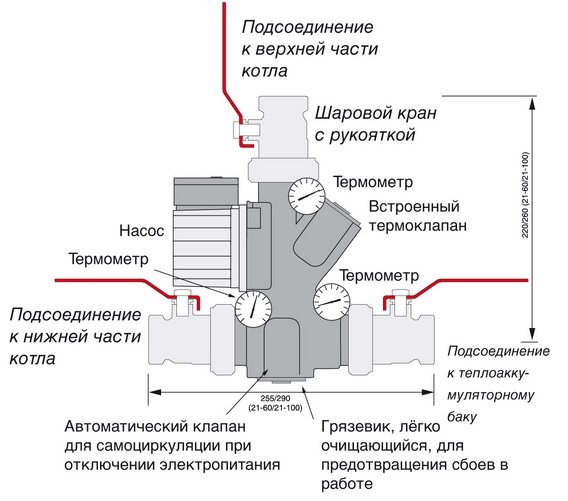

Connecting a heat accumulator to a solid fuel boiler
Block elements:
- circulation pump;
- three-way thermostatic valve;
- check valve;
- sump;
- Ball Valves;
- temperature control devices.
Differences from the previous scheme - all devices are assembled in one block, and the coolant goes to the tank, and not to the heating system. The principle of operation of the stirring unit remains unchanged. Such a piping of a solid fuel boiler with a heat accumulator allows you to connect as many heating branches as you like at the outlet from the tank. For example, to power radiators and floor or air heating systems. Moreover, each branch has its own circulation pump. All circuits are hydraulically separated, excess heat from the source is accumulated in the tank and used when needed.
Calculation of the capacity of the heat accumulator
The calculation methodology can be different depending on the application scheme. Here is a rough calculation chart:
- Determination of the maximum fuel load. For example, the firebox holds 20 kg of firewood. 1 kg of firewood is able to release 3.5 kWh of energy. Thus, when burning one bookmark of firewood, the boiler will give 20 3.5 = 70 kWh of heat. The time it takes for a complete bookmark to burn can be determined empirically or calculated. If the boiler output is, for example, 25 kW 70: 25 = 2.8 h.
- Heat carrier temperature in the heating system. If the system is already installed, it is enough to measure the temperature at the inlet and outlet and determine the heat loss.
- Determination of the desired download frequency. For example, loading is possible in the morning and in the evening, but it is not possible to service the boiler during the day and at night.
Calculation of the heat accumulator
If, for an hour, the heat loss of a room, for example, is 6.7 kW, then per day it will be 160 kW. In this example, this is slightly more than two fuel fillings. As it was defined above, one tab of firewood burns for about 3 hours, releasing 70 kWh of thermal energy.
The need for heating the house is 6.7 3 = 20.1 kWh, the storage tank reserve will be 70-20.1 = 49.9, that is, approximately 50 kWh. This energy will be enough for a period of 50: 6.7 - this is about 7 hours. This means that two full snacks and one incomplete one are required per day.
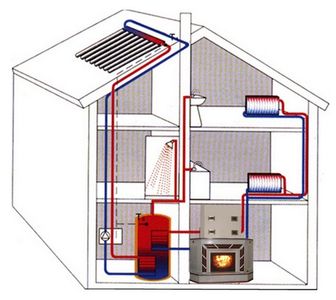

Based on these calculations, having considered several options, we will stop at this: at 23 o'clock, an incomplete load is made, at 6.00 and 18.00 - full. If you draw a graph of the charge level of the heat accumulator, you can see that the maximum charge falls on 60 kWh at 9 am.
Since 1 kWh = 3600 kJ, the reserve should be 60 3600 = 216000 kJ of thermal energy. The temperature reserve (the difference between the maximum water indicator and the required flow rate) is 95-57 = 38 ° С. Heat capacity of water 4.187 kJ. Thus, 216000 / (4.18738) = 1350 kg. In this case, the required volume of the heat accumulator will be 1.35 m3.
The considered example gives a general idea of how the storage tank capacity is calculated. In each individual case, it is necessary to take into account the peculiarities of the heating system and the conditions of its operation.
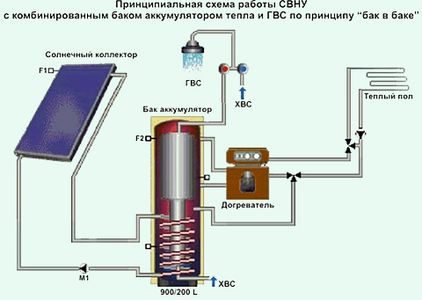

Features of installing a heat accumulator
Before installing the equipment, a detailed design must be drawn up. It is necessary to take into account all the requirements of the manufacturers of heating equipment. When installing the storage tank, the following rules must be observed:
- The surface of the container must have reliable thermal insulation.
- Thermometers should be installed at the inlet and outlet to monitor the temperature of the water.
- Volumetric tanks most often do not fit into the doorway. If it is not possible to bring in the tank before the end of construction, you will have to use a collapsible version or several smaller tanks.
- A coarse filter is desirable on the inlet pipe.
- A safety valve and a pressure gauge should be installed near the tank. There should also be an air vent valve in the tank itself.
- It must be possible to drain the water from the tank.
The use of a heat accumulator in a system with a solid fuel boiler increases the efficiency of the heat generator and its service life, and also allows more economical fuel consumption. Possibility of less frequent loading of fuel makes the use of the heating boiler more convenient for the consumer. The calculation of the required capacity of the storage tank must take into account the type of boiler, the characteristics of the heating system and the conditions of its operation.
Despite the simplicity of the device, and the obvious benefits of using heat accumulators, this type of equipment is not yet very common. In this article we will try to talk about what a heat accumulator is and the advantages that it brings with its use in heating systems.
Choosing a heat accumulator
TA choose when designing a heating system. Heating engineers will help you to choose the right heat accumulator. But, if it is impossible to use their services, you will have to choose yourself. This is not difficult to do.
Heat accumulator for solid fuel boiler
The main criteria for the selection of this device are considered to be the following
:
- pressure in the heating system;
- the volume of the buffer tank;
- external dimensions and weight;
- equipping with additional heat exchangers;
- the ability to install additional devices.
The water pressure (pressure) in the heating system is the main indicator. The higher it is, the warmer it is in the heated room. Considering this parameter, when choosing a heat accumulator for solid fuel boilers, attention is paid to the maximum pressure that it can withstand.The heat accumulator for a solid fuel boiler shown in the photo is made of stainless steel and can withstand high water pressure.
Buffer volume. The ability to store heat for the heating system during operation depends on it. The larger it is, the more heat will accumulate in the container. Here you need to take into account that it is pointless to increase the limit to infinity. But if the water is less than the norm, the device simply will not perform the function of heat accumulation assigned to it. Therefore, for the correct choice of a heat accumulator, it will be necessary to calculate its buffer capacity. It will be shown a little later how it is performed.
External dimensions and weight. These are also important indicators when choosing a TA. Especially in an already built house. When the calculation of the heat accumulator for heating is made, delivery to the installation site has been carried out, there may be a problem with the installation itself. In terms of overall dimensions, it may simply not fit into a standard door opening. In addition, TA of large capacity (from 500 liters) are installed on a separate foundation. A massive device filled with water will become even heavier. These nuances must be taken into account. But it's easy to find a way out. In this case, two heat accumulators are purchased for solid fuel boilers with a total volume of buffer tanks equal to the calculated one for the entire heating system.
Equipping with additional heat exchangers. In the absence of a DHW system in the house, its own water heating circuit in the boiler, it is better to immediately purchase a TA with additional heat exchangers. For those living in the southern regions, it will be useful to connect a solar collector to a TA, which will become an additional free source of heat in the house. A simple calculation of the heating system will show how many additional heat exchangers it is desirable to have in the heat accumulator.
Possibility of installing additional devices. This implies the installation of heating elements (tubular electric heaters), instrumentation (instrumentation), safety valves and other devices that ensure the uninterrupted and safe operation of the buffer tank in the device. For example, in the event of emergency damping of the boiler, the temperature in the heating system will be maintained by heating elements. Depending on the volume of heating the premises, they may not create a comfortable temperature, but they will definitely prevent defrosting of the system. The presence of instrumentation will allow you to pay attention to possible malfunctions in the heating system in a timely manner.
Important. When choosing a heat accumulator for heating, pay attention to its thermal insulation. The preservation of the obtained heat depends on it.
Application of heat accumulators
There are several methods for calculating the volume of a tank. Practical experience shows that, on average, 25 liters of water are required for each kilowatt of heating equipment. The efficiency of solid fuel boilers, which includes a heating system with a heat accumulator, increases to 84%. By leveling the combustion peaks, up to 30% of energy resources are saved.
When using tanks for domestic hot water supply, there are no interruptions during peak hours. At night, when the needs are reduced to zero, the coolant in the tank accumulates heat and in the morning again provides all the needs in full.
Reliable thermal insulation of the device with foamed polyurethane (polyurethane foam) helps to maintain the temperature. Additionally, it is possible to install heating elements, which helps to quickly "catch up" the desired temperature in case of emergency.
Sectional view of the heat accumulator
Heat storage is recommended in cases:
- great need for hot water supply. In a cottage, where more than 5 people live, and two bathrooms are installed, this is a real way to improve living conditions;
- when using solid fuel boilers.Accumulators smooth the operation of heating equipment in the hour of the greatest load, take away excess heat, preventing boiling, and also increase the time between filling solid fuel;
- when using electric energy at separate tariffs for daytime and nighttime;
- in cases where solar or wind batteries are installed to store electrical energy;
- when using circulation pumps in the heat supply system.
This system is perfect for rooms heated with radiators or underfloor heating. Its advantages are that it is able to store energy from different sources. The combined power supply system allows you to choose the most optimal option for generating heat for a given period of time.
Features of the design of the heat accumulator
The device is a cylindrical container made of stainless steel or black steel. The dimensions of the container depend on its volume, which varies from several hundred to tens of thousands of liters. Due to the large volumes, such a device is difficult to place in an existing boiler room, so it often has to be completed. There are models both with factory thermal insulation and containers without it.
When installing the heat accumulator, it must be borne in mind that the thickness of the insulation is 10 cm. After it, a leather casing is put on the top of the tank. Inside the tank there is a coolant, which, when fuel is burned in the boiler, heats up quickly and retains heat for a long time due to a layer of insulation. After stopping the operation of the boiler, the accumulator gives off its heat to the room, heating it. For this reason, the boiler will not need to be fired up as often as before.


According to their design, the capacities of the heat accumulator are:
- with a boiler located inside. This design was created to provide housing with hot water from an autonomous source;
- with one or two heat exchangers;
- empty (no coolant).
Threaded holes are provided for connecting the storage device to the boiler and the heating system of the house.
Background
It so happened that some time ago I bought a private house at a certain distance from civilization. The remoteness from civilization is mainly determined by the fact that there is no gas there at all. And the permitted power of the electrical connection does not provide the technical ability to heat the house with electricity. The only real source of heat in winter is the use of solid fuels. In other words, the house was equipped with a stove, which the former owner heated with wood and coal.
If someone has experience using the stove, then he does not need to be explained that this activity requires constant monitoring. Even in not too cold weather, it is impossible to put firewood in the stove once and “forget” about it. If you put too much wood on, the house will get hot. And after the fuel burns out, the house will cool down quickly anyway. Willy-nilly, to maintain a comfortable temperature, you need to constantly add a little firewood. And in severe frosts, the oven cannot be left unattended even for 3-4 hours. If you don't want to wake up in a cold room in the morning, be kind enough to go to the stove at least once a night ...
Of course, I had no desire to work as a fireman. And so I immediately began to think about a more convenient way of heating. Of course, if it was impossible to use gas or electricity, only a modern solid fuel heating system could become this way, consisting of a solid fuel boiler, a heat accumulator and the simplest automation for turning on and off the recirculation pump.
Why is a modern boiler better than a conventional stove? It takes up much less space, more fuel can be put in it, it provides better combustion of this fuel at maximum load, and theoretically it can be used to leave most of the heat in the house, and not be released into the chimney.But unlike a stove, a solid fuel boiler is practically impossible to use without a heat accumulator. I am writing about this in such detail, because I know many people who have tried to heat a house with such boilers, connecting them directly to heating pipes. They didn't do anything good.
What is a heat accumulator or, as it is also called, a buffer tank? In the simplest case, it is just a large barrel of water, the walls of which have good thermal insulation. The boiler heats up the water in this barrel in two to three hours of its operation. And then this hot water circulates through the heating system until it cools down. As it cools down, the boiler needs to be fired up again. The simplest heat accumulator can be easily done by any welder. But I, after a short thought, abandoned this idea and bought a ready-made one. Since I live in Ukraine, I turned to and never regretted it: here accumulation tanks are made professionally and very efficiently.
Depending on the volume of the heat accumulator, the power of the boiler and how much heat the house needs, the boiler has to be heated not constantly, but once or twice a day, or even once every two or three days.
Calculation of the volume of the buffer tank of the boiler
The most optimal solution to this problem will be the assignment of its implementation to heating engineers. Calculation of the volume of the heat accumulator for the entire heating system of a private house requires taking into account various factors known only to them. Despite this, preliminary calculations can be done independently. For this, in addition to general knowledge of physics and mathematics, you will need a calculator and a blank sheet of paper.
We find the following data
:
- boiler power, kW;
- active fuel combustion time;
- thermal power of heating the house, kW;
- Boiler efficiency;
- temperature in the supply pipe and "return".
Let's consider an example of preliminary calculation. The heated area is 200 m 2. The time of active combustion of the boiler is 8 hours, the temperature of the coolant during heating is 90 ° C, in the return circuit is 40 ° C. The estimated thermal power of the heated rooms is 10 kW. With such initial data, the heating device will receive 80 kW (10 × 8) of energy.
We calculate the buffer capacity of a solid fuel boiler by the heat capacity of water
:
where: m is the mass of water in the tank (kg); Q is the amount of heat (W); ∆t is the difference between the temperature of the water in the supply and return pipes (° С); 1.163 is the specific heat capacity of water (W / kg ° С) ...


Calculation of the buffer capacity of a solid fuel boiler
Substituting the numbers in the formula, we get 1375 kg of water or 1.4 m 3 (80,000 / 1.163 × 50). Thus, for a heating system of a house with an area of 200 m 2, it is necessary to install a TA with a capacity of 1.4 m 3. Knowing this figure, you can safely go to the store and see which heat accumulator is acceptable.
Dimensions, price, equipment, manufacturer are already easily identifiable. Comparing the known factors, it is not difficult to make a preliminary selection of a heat accumulator for a home. This calculation is relevant in the case when the house is built, the heating system has already been installed. The result of the calculation will show whether it is necessary to disassemble the doorways due to the dimensions of the TA. After evaluating the possibility of installing it in a permanent place, the final calculation of the heat accumulator for the solid fuel boiler installed in the system is made.
After collecting data on the heating system, we perform calculations using the formula
:
where: W is the amount of heat required to heat the coolant; m is the mass of water; c is the heat capacity; ∆t is the temperature of water heating;
In addition, you need the value of k - the efficiency of the boiler.
From formula (1) we find the mass: m = W / (c × ∆t) (2)
Since the boiler efficiency is known, we refine formula (1) and obtain W = m × c × ∆t × k (3) from which we find the updated mass of water m = W / (c × ∆t × k) (4)
Let's consider how to calculate a heat accumulator for a home. A 20 kW boiler is installed in the heating system (indicated in the passport data). The fuel tab burns out in 2.5 hours. To heat a house, you need 8.5 kW / 1 hour of energy. This means that during the burning out of one bookmark, 20 × 2.5 = 50 kW will be obtained
Space heating will consume 8.5 × 2.5 = 21.5 kW
Excess heat produced 50 - 21.5 = 28.5 kW is stored in the TA.
The temperature to which the coolant is heated is 35 ° C. (The temperature difference in the supply and return pipes. Determined by measurement during operation of the heating system). Substituting the sought values into formula (4), we obtain 28500 / (0.8 × 1.163 × 35) = 874.5 kg
This figure means that to store the heat generated by the boiler it is necessary to have 875 kg of heat carrier. To do this, you need a buffer tank for the entire system with a volume of 0.875 m 3. Such lightweight calculations make it easy to choose a heat accumulator for heating boilers.
Advice. For a more accurate calculation of the volume of the buffer tank, it is better to contact a specialist.
Online calculator
* If the calculator shows 0 (zero), it means you have no surplus energy that can be accumulated.
This is an approximate figure, as close as possible to reality, without taking into account such variables as: type of fuel, boiler efficiency, energy efficiency of the building.
Explanations
Boiler power according to the passport - each manufacturer indicates it from the documentation for the equipment. If the boiler was made independently and its power is unknown, it can be roughly determined empirically. For a house with an area of 100 m2, a boiler of 10 kW is enough... If your unit copes with the task of heating your house, with an average load of the firebox, take the area of this room as the main value and determine the power. You need to understand that these will be very average data, excluding heat loss, energy efficiency of the building, etc.
The power you need to heat your home. This is the energy needed to maintain the required temperature. It is calculated by a specialist based on complex formulas and many variables. For example, a house of 100m2 requires 8.5 kW of energy per hour. Again, this is a very average figure.
Heat carrier temperature, supply and return. The difference between these numbers will be the surplus that needs to be preserved.
Heat capacity of water. This is a tabular value, which is 4.19 kJ / kg × ° C or 1.164 W × h. It takes part in the calculations and is a statistical value.

